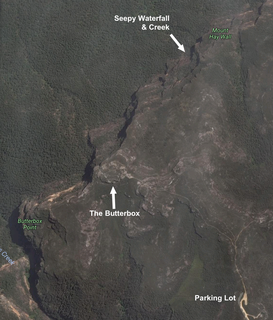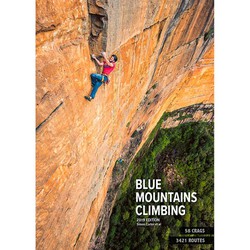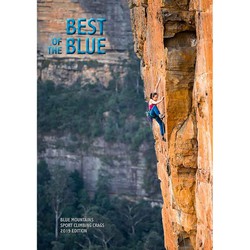

description
Mostly short, generally easy pitches but with a great 5th pitch (the eponymous pitch). This climb has not received many repeats, so be particularly careful if you plan to attempt the route.
The climb starts about 750m right (facing out) from the base of the Mt Hay canyon exit climb (head right soon after doing a short abseil off a big ring bolt). The start is on a small belay ledge about 5m up, about 20m past a small creek fed from a wide, dripping waterfall high up on the cliff.
15m (16) A nice technical start to the climb. Orange corner left of belay. Hard moves up the corner, then easier up the flake/crack and a gully to a tree belay to the left.
35m (walk) Walk and scramble up and left, then up a short corner to the base of the second short corner.
10m (10) Easy wall right of corner to long, narrow ledge below nice black ironstone slab
18m (15 R) Easily up unprotected black ironstone slab (numerous variants) to small ledge (piton up high to the left). Crank up short, steep wall (crux) on thin chickenheads to atmospheric belay ledge under roof (BB and cams). NOTE: Pitches 3 and 4 could be linked quite easily into a single pitch.
60m (15 R) The money pitch that the route is named after. Traverse right from the belay (be careful of the thin plates below where the ledge runs out), over the bulge on jugs then up the long slab above with sparse and wandery gear (double ropes recommended). Tree belay on halfway ledge. NOTE: This is a full 60m pitch - on the FA, the second started simulclimbing before the leader had reached the halfway ledge, which (given the minimal pro) was a tad "exciting". After the FA, a BB was added in the middle of this pitch, allowing it to be led as two pitches on a 50m rope instead (and making it safer if led as a single pitch).
30m (walk) Walk up halfway ledge to a pleasant belay under a small roof.
15m (10) Step right onto block then up to ledge. Up pleasant slab to ledge (tree belay).
25m (walk) Walk up and left to small ledge below hollow corner.
5m (13) Up hollow corner into cave (small cam with runner out onto face), then back onto the overhanging face and up to ledge.
20m (walk) Walk up and left to chossy cave. NOTE: From here on, the climb follows the easiest line to the top of the cliff, thereby avoiding a lot of the great looking rock on offer to the right. It is expected that a better, direct finish could be done beginning here, and heading out to the right on the nice looking slabs.
25m (8) Step left and up around arete to ledge, Straight up buttress (or walk up at left hand end). Scramble up to ledge below chossy roof.
25m (10) Walk left along ledge below chossy roof, then easily up blocks to base of pleasant black slab. Left and up the black slab to belay ledge below steep orange wall.
15m (12) Up choss to layback crack on right. Pleasant layback to top (tree belay 15m back).
To walk out, head up and right, passing an unusual "inverted V" cave. Keep heading right until the open heath is reached, at which point continue straight up the ridge top, up a short, steep white slab and over the top to the walking track. Walking time to the carpark: 20 minutes.
Route history
| 27 Sep 1998 | First ascent: Hayden Brotchie & Peter Monks (alt) |
|---|
Warnings
Location
- Lat/Lon: -33.61893, 150.40712
Some content has been provided under license from: © Australian Climbing Association Queensland (Creative Commons, Attribution, Share-Alike 2.5 AU)
Grade citation
| 16 R | Assigned grade |
| 16 | Hayden Brotchie |
| 16 R | ★private |
| 22 [21 - 23] ++ | grAId |
ethic
Although sport climbing is well entrenched as the most popular form of Blueys climbing, mixed-climbing on gear and bolts has generally been the rule over the long term. Please try to use available natural gear where possible, and do not bolt cracks or potential trad climbs. If you do the bolts may be removed.
Because of the softness of Blue Mountains sandstone, bolting should only be done by those with a solid knowledge of glue-in equipping. A recent fatality serves as a reminder that this is not an area to experiment with bolting.
If you do need to top rope, please do it through your own gear as the wear on the anchors is both difficult and expensive to maintain.
At many Blue Mountains crags, the somewhat close spacing of routes and prolific horizontal featuring means that it is easy to envisage literally hundreds of trivial linkups. By all means climb these to your hearts content but, unless it is an exceptional case due to some significant objective merit, please generally refrain from writing up linkups. A proliferation of descriptions of trivial linkups would only clutter up the guide and add confusion and will generally not add value to your fellow climbers. (If you still can't resist, consider adding a brief note to the parent route description, rather than cluttering up the guide with a whole new route entry).
If you have benefited from climbing infrastructure in NSW, please consider making a donation towards maintenance costs. The Sydney Rockclimbing Club Rebolting Fund finances the replacement of old bolts on existing climbs and the maintenance of other hardware such as fixed ropes and anchors. The SRC purchases hardware, such as bolts and glue, and distributes them to volunteer rebolters across the state of New South Wales. For more information, including donation details, visit https://sydneyrockies.org.au/rebolting/
It would be appreciated if brushing of holds and minimisation/removal of tick marks becomes part of your climbing routine. Consider bringing a water squirt bottle and mop-up rag to better remove chalk. Only use soft (hair/nylon) bristled brushes, never steel brushes.
The removal of vegetation - both from the cliff bases and the climbs - is not seen as beneficial to aesthetics of the environment nor to our access to it.
Remember, to maintain access our best approach is to 'Respect Native Habitat, Tread Softly and Leave No Trace'. Do not cut flora and keep any tracks and infrastructure as minimal as possible or risk possible closures.
For the latest access related information, or to report something of concern, visit the Australian Climbing Association NSW Blue Mountains page at https://acansw.org.au/blue-mountains/
Seasonality
Quality
Overall quality 67 from 2 ratings.
Tick Types
Comment keywords
Selected Guidebooks more Hide
Author(s): Simon Carter
Date: 2019
ISBN: 9780958079082
The latest comprehensive, latest and greatest Blue Mountains Climbing Guide is here and it has more routes than you can poke a clip stick at! 3421 to be exact. You are not going to get bored.
Author(s): Simon Carter
Date: 2019
ISBN: 9780958079075
Simon Carter's "Best of the Blue" is the latest selected climbing guide book for the Blue Mountains and covers 1000 routes and 19 different climbing areas. For all the sport climbers out there, the travellers, or just anyone who doesn't want to lug around the big guide that's more than 3 times the size - cut out the riff-raff and get to the good stuff! This will pretty much cover everything you need!
Accommodations nearby more Hide
Share this
Photos Browse all photos

Melissa Thomas on ★★ Monks Wall 16 R - P4 atmospheric belay
Get a detailed insight with a timeline showing
- Ticks by climbers like you
- Discussions of the community
- Updates to the index by our users
- and many more things.
Login to see the timeline!


